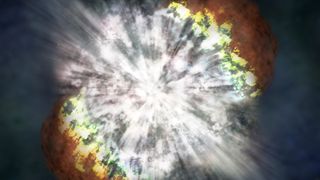News
Science & Astronomy

An artist’s impression of a supernova explosion.
(Image credit: M. Weiss/NASA/CXC via Getty Images)
Astronomers have turned to deep learning to simulate cosmic explosions that occur when massive stars die, in order to improve their understanding of galactic formation and evolution.
More accurate modeling of tricky-to-simulate aspects of supernovas could shed light on how the chemical elements needed for life are dispersed through the cosmos, researchers say.
The new development is the work of a team led by University of Tokyo astronomer Keiya Hirashima, who was inspired by first applying deep learning — which helps computers recognize patterns across various datasets — to weather for an event called Hackathon.
“Weather is a very complex phenomenon, but ultimately, it boils down to fluid dynamics calculations,” Hirashima said in a statement. “So, I wondered if we could modify deep learning models used for weather forecasting and apply them to another fluid system, but one that exists on a vastly larger scale and which we lack direct access to — my field of research, supernova explosions.”
Related: AI just spotted its 1st supernova. Could it replace human explosion hunters?
How supernovas tie generations of stars together
During their lives, stars forge chemical elements within their cores via nuclear fusion, which smashes together atoms of lighter elements to create heavier elements, with the mass difference released as energy that allows the star to shine. The more massive a star, the heavier the elements it can forge — but all stellar bodies have their limits.
When a star can no longer forge subsequently heavier elements, nuclear fusion stops, and as a result, so does the outward pressure that for millions or billions of years has protected the star against the inward crushing force of its own gravity. As the star’s core collapses, the outer layers are flung outward in a massive explosion called a supernova. This spreads the cornucopia of elements the star has crafted during its life into deep space.
This material eventually finds its way into the next generation of stars and the planets orbiting them. Eventually, this star stuff is incorporated into any lifeforms that happen to evolve on those worlds — for instance, humans. That means supernovas are vital to deciphering the origin story of us.
Supernovas are so powerful that they also have a massive influence on the galaxies around them, meaning they are key players in facets of galactic evolution other than chemical enrichment. Thus, knowing how supernovas behave is key to knowing how galaxies change over time.
“The problem is the time it takes to calculate the way supernovae explode. Currently, many models of galaxies over long time spans simplify things by pretending supernovae explode in a perfectly spherical fashion, as this is relatively easy to calculate,” Hirashima said. “However, in reality, they are quite asymmetric. Some regions of the shell of material that forms the boundary of the explosion are more complex than others.”
The application of deep learning helped the scientists determine which parts of the explosion require more attention during a simulation and which require less. This ensured the best accuracy and also reduced the overall time needed for the calculations involved.
“This way of dividing a problem is called Hamiltonian splitting,” Hirashima added. “Our new model, 3D-MIM, can reduce the number of computational steps in the calculation of 100,000 years of supernova evolution by 99%. So, I think we’ll really help reduce a bottleneck, too.”
That may sound straightforward, but deep learning requires deep training, and to train the system, the team had to run hundreds of simulations, which took millions of hours of computer time. The titanic effort was worth it, with the team now hoping the method used to create 3D-MIM can be applied to other astrophysical phenomena that influence galactic evolution. This includes the birth of large star-forming patches of galaxies called starburst regions.
The team has applied 3D-MIM to the end of stars’ lives and could also now apply the same model to the beginning of their lives, thus better modeling stellar birth, too.
The team’s research was published online last month in the journal Monthly Notices of the Royal Astronomical Society.
Join our Space Forums to keep talking space on the latest missions, night sky and more! And if you have a news tip, correction or comment, let us know at: [email protected].
Breaking space news, the latest updates on rocket launches, skywatching events and more!
Robert Lea is a science journalist in the U.K. whose articles have been published in Physics World, New Scientist, Astronomy Magazine, All About Space, Newsweek and ZME Science. He also writes about science communication for Elsevier and the European Journal of Physics. Rob holds a bachelor of science degree in physics and astronomy from the U.K.’s Open University. Follow him on Twitter @sciencef1rst.
>>> Read full article>>>
Copyright for syndicated content belongs to the linked Source : Space.com – https://www.space.com/deep-learning-supernova-explosions-cosmic-origins































